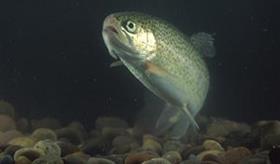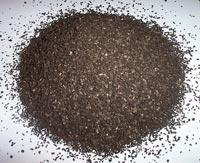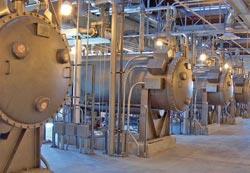Water companies around the world are investigating the best ways to remove traces of endocrine disrupting chemicals from wastewater, as Maria Burke finds out.
Water companies around the world are investigating the best ways to remove traces of endocrine disrupting chemicals from wastewater, as Maria Burke finds out.
Strange things have been happening in British rivers over the past few decades. Male fish with eggs in their testes. Fish that are neither wholly female nor wholly male. Fish that are losing their ability to reproduce.
British researchers were the first to observe gender changes in river fish, back in the 1980s. Their investigations continued over the next 20 years and culminated in a major report in 2003 that showed sexual disruption in fish was widespread throughout rivers in England and Wales.

These fish were found downstream of domestic sewage effluents. It seemed that some rivers were receiving discharges from sewage treatment works that contained tiny concentrations of certain chemicals and that these chemicals were ’feminising’ male fish.
A catch-all term for these compounds is endocrine disrupting chemicals (EDCs). This means they can mimic, or interfere with, hormones such as the female hormone oestrogen. They include industrially derived oestrogen mimics, such as nonylphenol, a breakdown product of a range of commonly used non-ionic surfactants; and natural steroid oestrogens, such as 17 β-oestradiol (E2) and oestrone (E1), which are excreted by all humans, together with 17 α-ethynyloestradiol (EE2), the active ingredient in the contraceptive pill.
Many major sewage treatment works use activated sludge to treat sewage water. In this process, bacteria fuelled by oxygen break down organic matter. However, a small proportion of EDCs do escape in the effluent water. In general, activated sludge plants remove 70-88 per cent of E2, 50-75 per cent of E1 and 50-85 per cent of EE2 from the waste stream, according to Andrew Johnson of the Natural Environment Research Council’s Centre for Ecology and Hydrology at Wallingford, UK.
This still leaves 1-10 ng/L (parts per trillion) in the effluent. EDCs are fairly soluble in water, but if the wastewater is not diluted sufficiently and quickly even these small concentrations can have a drastic impact on sensitive fish species, he says.
Testing times
Water companies around the world are investigating the best ways to remove EDCs from wastewaters, their research efforts driven by these environmental factors.
At present, there is no research to suggest that human health may be at risk from EDCs in drinking water, says Frans Schulting, managing director of the Global Water Research Coalition, because water treatments are so effective and concentrations of EDCs are so low in developed countries. However, he adds, it is a completely different picture when untreated surface water is used as drinking water, which is often the case in rural areas and informal settlements in urban areas of developing countries.

There are several kinds of potential removal processes. Some use physical means to act as a barrier or trap (activated carbon or membrane filtration). Others use oxidation to break down the molecules or form different molecules (ozonation, chlorination or ultraviolet irradiation); or biological processes (soil aquifer treatment, membrane bioreactors or river bank filtration).
Granular activated carbon
In the UK, the water industry is testing a number of technologies. For example, the water companies, Thames Water and Severn Trent, are designing two full-scale demonstration plants using granular activated carbon (GAC) technology at existing treatment works.
’We’ve chosen GAC instead of other methods because it is the most robust and reliable process currently available,’ explains Christopher Shipway of Thames Water. ’We’re currently at the design phase of the project, and expect to have the new treatment plant running in March 2008.’ The demonstration plants will adapt GAC designs from drinking water treatment plants.

GAC is already used in the industry to treat drinking water, says Tony Butwell of WRc, a technology consultancy to the water industry. ’It is known to remove some important EDCs and can remove chemicals even at the exceptionally low concentrations - parts per trillion - that EDCs occur.’
GAC technology is based on carbon, often derived from coconut shells, coal or wood, which has been ’activated’ by heating it. This process creates small porous particles with a very large surface area for absorption. An activated carbon filter generally consists of one or more columns of granules.
Water is pumped through a column from the top down. As it flows through, chemicals stick to the surface, and within the pores of the granules. (Most tap water filters and fish tank filters at home contain activated carbon and work in the same way.) Part of the surface area of each activated carbon particle is positively charged and attracts negatively charged contaminants.
To enhance removal of some contaminants, the carbon can be ’tailored’ by coating the surface with a thin layer of a surface-active substance, which has an abundance of positive charges.
The studies will look at how to keep the carbon filters performing well and how to keep costs down. ’Sewage effluent is much dirtier than drinking water so there will be a new range of problems to address,’ says Butwell. The carbon filters will need to be replaced regularly because organic matter in the effluent will clog them up, he explains. This also adds to the expense.
As part of a national research programme, the water industry is testing other technologies as well as GAC. A second study is to monitor how well existing treatments, such as ultraviolet and biological treatment processes, remove EDCs at 17 sites over the next five years. Monitoring is due to start at two sites this spring, and the rest will follow over the next 18 months.
’We know there is no obvious ideal solution,’ says Butwell, whose organisation, WRc, is coordinating monitoring for the national programme. ’All options have potentially significant costs and some have downstream water quality concerns. I see the role of GAC as providing a performance and economic benchmark against which other (possibly better) technologies can be evaluated. This work should allow us to select the best value option for the UK if we need to apply such treatment in the future.’
The companies will report their findings to the UK government in 2010. ’This will provide valuable information on the cost effectiveness of a range of treatment options to inform any future regulatory strategy,’ says Nick Cartwright of the Environment Agency of England and Wales.
Meanwhile, the agency is continuing to refine its risk assessment. ’Advanced treatment, such as GAC, is unlikely to be necessary at all sites,’ he adds, ’as this depends on the dilution available in the rivers.’
Defra, the UK department of the environment, food and rural affairs, has estimated that 142 sewage works are at high risk, 191 sites are classified as medium risk and 132 sites are low risk. The capital cost of implementing GAC could be between £2.1 and £2.8 million per works.
Global water issues
The UK is not alone in investigating removal technologies for EDCs. In the US, the water industry has been busy doing its own evaluations.
Shane Snyder, project manager at the Southern Nevada Water Authority, has authored several recent studies comparing technologies, including GAC.

’Activated carbon works wonderfully initially, but it is quite inefficient in wastewater where there is a high organic matter content,’ he explains. ’The carbon beds are quickly exhausted and need constant regeneration. One way round this would be to use other treatment processes first, such as nanofilters to remove most of the organic matter, but this adds to the expense.’
Snyder has recently evaluated two full-scale GAC applications in the US, and concluded that activated carbon can remove more than 90 per cent of compounds including EDCs. However, regenerating or replacing the GAC was critical. ’Their efficiency was greatly reduced by the presence of natural organic matter, which competes for binding sites and can block pores within the activated carbon structure. Also, water-soluble contaminants like EDCs can break through the GAC relatively rapidly.’ Snyder also points out that GAC creates new environmental problems because it does not destroy the contaminants, it only removes them. The carbon needs to be landfilled, or treated thermally for reuse. ’Incineration processes cause air pollution, which is a huge issue for us,’ he says.
For wastewater particularly, Snyder favours ozonation, where gas is bubbled through effluent water and oxidises contaminants. ’It destroys EDCs, it can run constantly, and it can be stepped up or down depending on the effluent,’ he says. There is another advantage, too. Around eight per cent of the gas is ozone, the rest is oxygen.
In a wastewater plant, this oxygen can be collected off the top of the tank and re-routed back to the bacteria in the activated sludge tank. ’The bacteria go crazy,’ says Snyder.
However, the main disadvantage of ozonation is that it can form byproducts, although this is not such a concern in wastewater as in drinking water. If there are bromides in the water, from seawater for example, then ozonation can form bromates. Bromates are regulated by the US Environmental Protection Agency in drinking water, but not in wastewater. ’We have not seen any data to show that they are an environmental hazard,’ says Snyder.
’Structurally, by and large, we expect the toxicity of byproducts to be less than EDCs. What’s more, we have shown that ozonation byproducts don’t have hormone-mimicking effects.’
In a report published in August last year, Snyder evaluated several water treatments commonly used in the US, including chlorination, ozonation, and UV treatment. Ozonation reduced 26 out of 31 chemicals to at least 30 per cent of their original concentration. These substances included testosterone and oestrogen. Using chlorination, 15 of the chemicals remained at levels exceeding 70 per cent of their original concentration. UV treatment was even less effective. ’At the dose used in most plants for disinfection, there is essentially no removal of these types of compounds,’ says Snyder.
Thomas Ternes at the Bundesanstalt für Gewässerkunde (Federal Institute of Hydrology) in Koblenz, Germany, has also studied ozonation techniques, including pilot-scale treatments on wastewater plants. ’We found in two pilot ozone trials that this technique removed 99 per cent of oestrogens,’ he reports.
His team identified 20 byproducts of ozonation and found no concerns with their toxicity. ’Ozonation increases polarity of the compounds and makes them more soluble in water and, as a rule of thumb, increased polarity is linked to lower toxicity,’ he says.
As well as ozonation, the German water industry is looking at GAC technology and membrane bioreactors. GAC technology removes endocrine disrupters very efficiently, says Ternes, but it is an expensive option for wastewater treatment because the carbon needs to be replaced regularly.
Another possibility in modern sewage works is to leave the sludge for longer, perhaps up to 14 days, which allows the bacteria to degrade EDCs more efficiently. To make sure all EDCs are removed, ozonation or GAC could be added at the end. However, Ternes says, this may not be cost-effective in older works, which would have to be enlarged to allow for longer sludge retention times.
Membrane technology
Another way of increasing sludge retention times without having to modify existing works would be to use a membrane bioreactor. In this process, bacteria grow on or behind a permeable membrane, adding another barrier to contaminants passing through into the wastewater.
Snyder has also studied membrane processes and concluded that a multi-barrier approach is the most successful at removing trace contaminants. He found that membranes were effective at reducing the concentration of a diverse set of EDCs during both drinking water and wastewater treatment. Reverse osmosis is probably the best way of removing EDCs, says Snyder. In this process, wastewater passes over a very thin polymer film, and water is driven under pressure through the membrane in the opposite direction to contaminants. But it is tremendously energy-intensive and the contaminant-containing brine must be disposed of somehow. In California, which has the largest reverse osmosis wastewater treatment system in the world, this brine is dumped in the sea.
Snyder identifies nanofiltration, where the membrane has nano-sized pores, as one of the most promising up-and-coming membrane processes. Although energy efficiency is better than for reverse osmosis, there is still the issue of brine disposal. A possible solution, being studied by his group, is to apply ozonation to the brine after filtering.
No silver bullet
As yet, removal technologies are not applied anywhere in the world on a large-scale. Research groups and the water industry continue to grapple with understanding and solving a range of technical problems. ’There is no silver bullet. Each technology has upsides and downsides,’ concludes Snyder. In the end, perhaps, it will depend on how much government and industry are willing to pay.
Maria Burke is a freelance science writer based in St Albans, UK
Companies
- USFilter, Pennsylvania, US, is owned by the German company Siemens. This year USFilter will be renamed Siemens Water Technologies. The company provides a wide range of water purification systems, including ion exchange systems and membrane bioreactors.
- Derwent Water Systems is based in Matlock, UK. It supplies water treatment equipment including filters and reverse osmosis plants.
- General Carbon Corporation, New Jersey, US, sells a range of wastewater treatment tools including impregnated and activated carbon. The activated carbon products are made from materials such as coal, coconut shell and wood.
- Biwater is based in Dorking, UK, and offers a range of water and wastewater treatment services around the world.
- Kinetico, based in Ohio, US, provides a range of water treatment systems including membrane separation technologies, nanofiltration, reverse osmosis and activated carbon systems. The company’s UK subsidiary is based in Southampton.
- Environmental Water Systems is based in Somerset, UK. The company designs, manufactures and services wastewater treatment and recovery systems.
- Zenon is based in Ontario, Canada. It sells a range of industrial wastewater treatment systems including membrane bioreactor technology.
- GE Infrastructure, Water and Process Technologies is based in Massachusetts, US. The company sells water treatment equipment including membrane bioreactors, reverse osmosis, ultrafiltration and electrodialysis reversal technologies.
- Ondeo Industrial Solutions is based in Vaucresson, France, and is fully owned by French firm Suez. It provides services, engineering and equipment for industrial water and wastewater treatment.






No comments yet